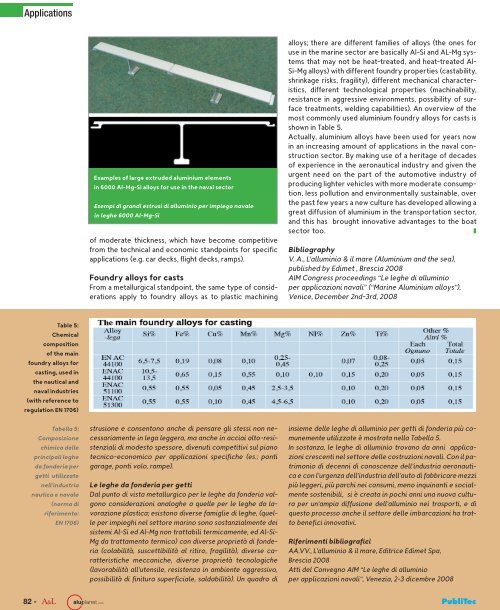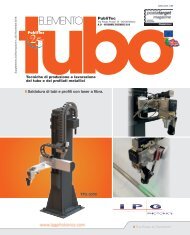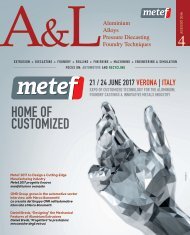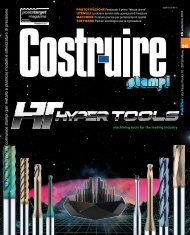Sfogliabile_AeL_n3_GIUGNO_2016
- No tags were found...
You also want an ePaper? Increase the reach of your titles
YUMPU automatically turns print PDFs into web optimized ePapers that Google loves.
Applications<br />
Examples of large extruded aluminium elements<br />
in 6000 Al-Mg-Si alloys for use in the naval sector<br />
Esempi di grandi estrusi di alluminio per impiego navale<br />
in leghe 6000 Al-Mg-Si<br />
of moderate thickness, which have become competitive<br />
fromthetechnicalandeconomicstandpointsforspecific<br />
applications (e.g. car decks, flight decks, ramps).<br />
Foundry alloys for casts<br />
From a metallurgical standpoint, the same type of considerations<br />
apply to foundry alloys as to plastic machining<br />
alloys; there are different families of alloys (the ones for<br />
useinthemarinesectorarebasicallyAl-SiandAL-Mgsystems<br />
that may not be heat-treated, and heat-treated Al-<br />
Si-Mg alloys) with different foundry properties (castability,<br />
shrinkage risks, fragility), different mechanical characteristics,<br />
different technological properties (machinability,<br />
resistance in aggressive environments, possibility of surface<br />
treatments, welding capabilities). An overview of the<br />
most commonly used aluminium foundry alloys for casts is<br />
shown in Table 5.<br />
Actually, aluminium alloys have been used for years now<br />
in an increasing amount of applications in the naval construction<br />
sector. By making use of a heritage of decades<br />
of experience in the aeronautical industry and given the<br />
urgent need on the part of the automotive industry of<br />
producing lighter vehicles with more moderate consumption,<br />
less pollution and environmentally sustainable, over<br />
the past few years a new culture has developed allowing a<br />
great diffusion of aluminium in the transportation sector,<br />
and this has brought innovative advantages to the boat<br />
sector too.<br />
❚<br />
Bibliography<br />
V. A., L’alluminio & il mare (Aluminium and the sea),<br />
published by Edimet , Brescia 2008<br />
AIM Congress proceedings “Le leghe di alluminio<br />
per applicazioni navali” (“Marine Aluminium alloys”),<br />
Venice, December 2nd-3rd, 2008<br />
Table 5:<br />
Chemical<br />
composition<br />
of the main<br />
foundry alloys for<br />
casting, used in<br />
the nautical and<br />
naval industries<br />
(with reference to<br />
regulation EN 1706)<br />
Tabella 5:<br />
Composizione<br />
chimica delle<br />
principali leghe<br />
dafonderiaper<br />
getti utilizzate<br />
nell’industria<br />
nautica e navale<br />
(norma di<br />
riferimento:<br />
EN 1706)<br />
strusioneeconsentonoanchedipensareglistessinonnecessariamente<br />
in lega leggera, ma anche in acciai alto-resistenziali<br />
di modesto spessore, divenuti competitivi sul piano<br />
tecnico-economico per applicazioni specifiche (es.: ponti<br />
garage, ponti volo, rampe).<br />
Le leghe da fonderia per getti<br />
Dal punto di vista metallurgico per le leghe da fonderia valgono<br />
considerazioni analoghe a quelle per le leghe da lavorazione<br />
plastica; esistono diverse famiglie di leghe, (quelle<br />
per impieghi nel settore marino sono sostanzialmente dei<br />
sistemiAl-SiedAl-Mgnontrattabilitermicamente,edAl-Si-<br />
Mgdatrattamentotermico)condiverseproprietàdifonderia(colabilità,suscettibilitàalritiro,fragilità),diversecaratteristiche<br />
meccaniche, diverse proprietà tecnologiche<br />
(lavorabilità all’utensile, resistenza in ambiente aggressivo,<br />
possibilità di finitura superficiale, saldabilità). Un quadro di<br />
insiemedelleleghedialluminiopergettidifonderiapiùcomunemente<br />
utilizzate è mostrata nella Tabella 5.<br />
In sostanza, le leghe di alluminio trovano da anni applicazioni<br />
crescenti nel settore delle costruzioni navali. Con il patrimonio<br />
di decenni di conoscenze dell’industria aeronauticaeconl’urgenzadell’industriadell’autodifabbricaremezzi<br />
più leggeri, più parchi nei consumi, meno inquinanti e socialmente<br />
sostenibili, si è creata in pochi anni una nuova culturaperun’ampiadiffusionedell’alluminioneitrasporti,edi<br />
questo processo anche il settore delle imbarcazioni ha tratto<br />
benefici innovativi.<br />
Riferimenti bibliografici<br />
AA.VV., L’alluminio & il mare, Editrice Edimet Spa,<br />
Brescia 2008<br />
Atti del Convegno AIM “Le leghe di alluminio<br />
per applicazioni navali”, Venezia, 2-3 dicembre 2008<br />
82 - .com<br />
PubliTec





